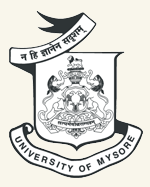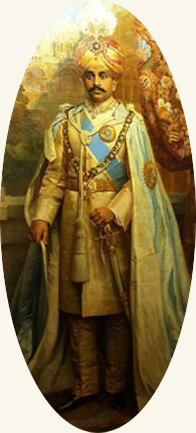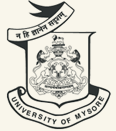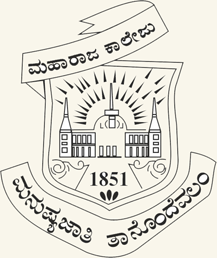
The University emblem is adapted from the Royal Emblem of Mysore. It depicts the bird Gandabherunda flanked on either side by the lion-elephant Sharabha (mythical creature believed to be stronger than the lion and the elephant, and upholder of righteousness), surmounted by a lion. The motto of the University, as envisaged in its emblem is, "Nothing is Equal to Knowledge" and the second line "I Always Uphold The Truth"summarizes the vision, moral fabric and idealism of the Founders and of the University.
 The University of Mysore was established on 27th July, 1916 during the benevolent reign of the Maharaja of Mysore, His Highness Nalvadi Krishnaraja Wodeyar (1884-1940). The genesis of the University of Mysore stems from a five year long in-depth reading and analysis on higher education across the globe. The mission of the University of Mysore, laid down in the 1916 regulations published in the Mysore Gazette Extraordinary, aims at ‘promoting teaching and research in conventional and traditional domains of Arts, Humanities, Pure and Applied Sciences and Professional disciplines’.
The University of Mysore was established on 27th July, 1916 during the benevolent reign of the Maharaja of Mysore, His Highness Nalvadi Krishnaraja Wodeyar (1884-1940). The genesis of the University of Mysore stems from a five year long in-depth reading and analysis on higher education across the globe. The mission of the University of Mysore, laid down in the 1916 regulations published in the Mysore Gazette Extraordinary, aims at ‘promoting teaching and research in conventional and traditional domains of Arts, Humanities, Pure and Applied Sciences and Professional disciplines’.
Sir M Visvesvaraya (1860-1962) played a decisive role in the launch of the University. The University, since then, has gone through different phases of development. Started with just two faculties, namely Arts and Science offering BA, BSc, BCom and BT courses, the University added Engineering faculty in 1917, MA programs at Maharaja's College, Mysore. In 1918, MSc program at Central College, Bangalore in 1919 and the faculty of Medicine in Mysore during1924 , thus laying a firm foundation for the multi-faculty character of the university. In 1941, new courses leading to BA honours were added.
During the post-independent period, from 1947-1960, the University enacted new Act of 1956 which ushered in academic autonomy. It also facilitated the introduction of PreUniversity System of education by abolishing intermediate courses. With the support of the University Grants Commission (UGC), which came into existence in 1956, post-graduate education was expanded significantly.
In 1960, a major development was the conglomeration of all the post-graduate studies of the University at one location during the tenure of the ViceChancellorship of Dr. K.V. Puttappa. This location was christened "Manasagangotri" meaning ` eternal spring of the mind’ adjacent to Kukkarahalli lake within the heart of the heritage city of Mysore in a picturesque area of 739 acres. The year 1966 was commemorated as the Golden Jubilee year and a corpus fund of Rs 2.85 crores was instituted for awards and prizes under various categories.
Today the University has 42 Postgraduate Departments at the Main Campus, Manasagangotri, 2 Postgraduate Centres, viz., Tubinakere, Mandya, Hemagangotri, Hassan with 5 Postgraduate Departments each and one Satellite Centre at Chamarajanagar with 3 Postgraduate Departments. It is providing higher education to about 85 lakhs students, of which over 10,000 are Postgraduates. As many as 1400 students are from 50 countries pursuing higher studies in this University. Some of these countries are China, Iran, Jordan, Thailand, Indonesia, Egypt, Syria, Tanzania, Uzbekistan, Kajkhastan, Kirghizia, Mongolia, Uganda, Yemon, Kenya, Palestine, Srilanka, Bangladesh and Nepal. While adopting and realizing the policy of inclusive growth creating opportunities to every deserving persons new courses and programs such as Masters in Biotechnology, Microbiology, Electronics, Genetics, Electronic Media, Geographical Information Systems, Information Technology and Management, Computer Cognition Technology, Financial Analysis and Management, Tourism Administration etc., have been introduced in a phased manner to meet the emerging needs of the technology and society and to develop necessary human resources. Career Oriented Courses, such as e-commerce, Bio-informatics, Clinical Informatics, Office Automation etc., are also being offered.


